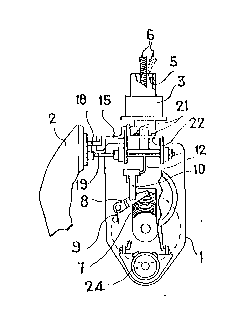Une partie des informations de ce site Web a été fournie par des sources externes. Le gouvernement du Canada n'assume aucune responsabilité concernant la précision, l'actualité ou la fiabilité des informations fournies par les sources externes. Les utilisateurs qui désirent employer cette information devraient consulter directement la source des informations. Le contenu fourni par les sources externes n'est pas assujetti aux exigences sur les langues officielles, la protection des renseignements personnels et l'accessibilité.
L'apparition de différences dans le texte et l'image des Revendications et de l'Abrégé dépend du moment auquel le document est publié. Les textes des Revendications et de l'Abrégé sont affichés :
| (12) Demande de brevet: | (11) CA 2049213 |
|---|---|
| (54) Titre français: | DISPOSITIF POUR POUPEES, ENTRAINEMENT POUR LE MOUVEMENT DE LA TETE ET PRODUCTION SONORE |
| (54) Titre anglais: | DEVICE FOR DOLLS, ACTIVATOR OF HEAD MOVEMENT, VOICE SOUND AND LIGHT |
| Statut: | Réputée abandonnée et au-delà du délai pour le rétablissement - en attente de la réponse à l’avis de communication rejetée |
| (51) Classification internationale des brevets (CIB): |
|
|---|---|
| (72) Inventeurs : |
|
| (73) Titulaires : |
|
| (71) Demandeurs : |
|
| (74) Agent: | MACRAE & CO. |
| (74) Co-agent: | |
| (45) Délivré: | |
| (22) Date de dépôt: | 1991-08-14 |
| (41) Mise à la disponibilité du public: | 1992-06-12 |
| Licence disponible: | S.O. |
| Cédé au domaine public: | S.O. |
| (25) Langue des documents déposés: | Anglais |
| Traité de coopération en matière de brevets (PCT): | Non |
|---|
| (30) Données de priorité de la demande: | ||||||
|---|---|---|---|---|---|---|
|
A B S T R A C T
DEVICE FOR DOLLS, ACTIVATOR OF HEAD MOVEMENT, VOICE SOUND AND
LIGHT.
This device is based on a piece which is moved when the
doll's arm is lifted, causing her head to rotate towards that arm
and closing the circuit which produces laughing sounds and
sentences. On the other hand, when the doll's arm is down the
circuit activation produces crying sounds. When the arm is down,
the above mentioned circuit is activated by pushing the doll's
head sideways, either by pulling her hair combing it or by any
other circumnstance This tilt places a vertical elastic appendix
on a ring - both elements are fit-ted in the head's assembly core,
thus closing the above mentioned circuit. Figure n? 2.
Note : Les revendications sont présentées dans la langue officielle dans laquelle elles ont été soumises.
Note : Les descriptions sont présentées dans la langue officielle dans laquelle elles ont été soumises.

2024-08-01 : Dans le cadre de la transition vers les Brevets de nouvelle génération (BNG), la base de données sur les brevets canadiens (BDBC) contient désormais un Historique d'événement plus détaillé, qui reproduit le Journal des événements de notre nouvelle solution interne.
Veuillez noter que les événements débutant par « Inactive : » se réfèrent à des événements qui ne sont plus utilisés dans notre nouvelle solution interne.
Pour une meilleure compréhension de l'état de la demande ou brevet qui figure sur cette page, la rubrique Mise en garde , et les descriptions de Brevet , Historique d'événement , Taxes périodiques et Historique des paiements devraient être consultées.
| Description | Date |
|---|---|
| Le délai pour l'annulation est expiré | 1994-02-15 |
| Demande non rétablie avant l'échéance | 1994-02-15 |
| Réputée abandonnée - omission de répondre à un avis sur les taxes pour le maintien en état | 1993-08-16 |
| Inactive : Demande ad hoc documentée | 1993-08-16 |
| Demande publiée (accessible au public) | 1992-06-12 |
| Date d'abandonnement | Raison | Date de rétablissement |
|---|---|---|
| 1993-08-16 |
Les titulaires actuels et antérieures au dossier sont affichés en ordre alphabétique.
| Titulaires actuels au dossier |
|---|
| FABRICAS AGRUPADAS DE MUNECAS DE ONIL S.A. |
| Titulaires antérieures au dossier |
|---|
| JAIME FERRI |